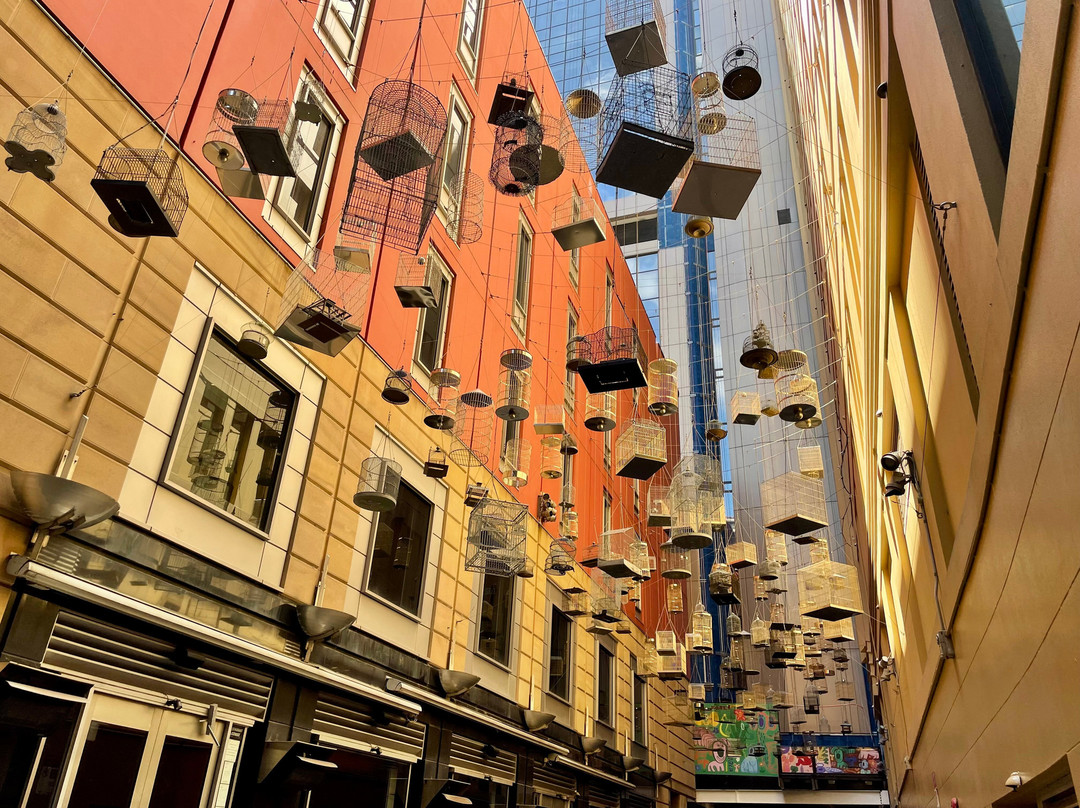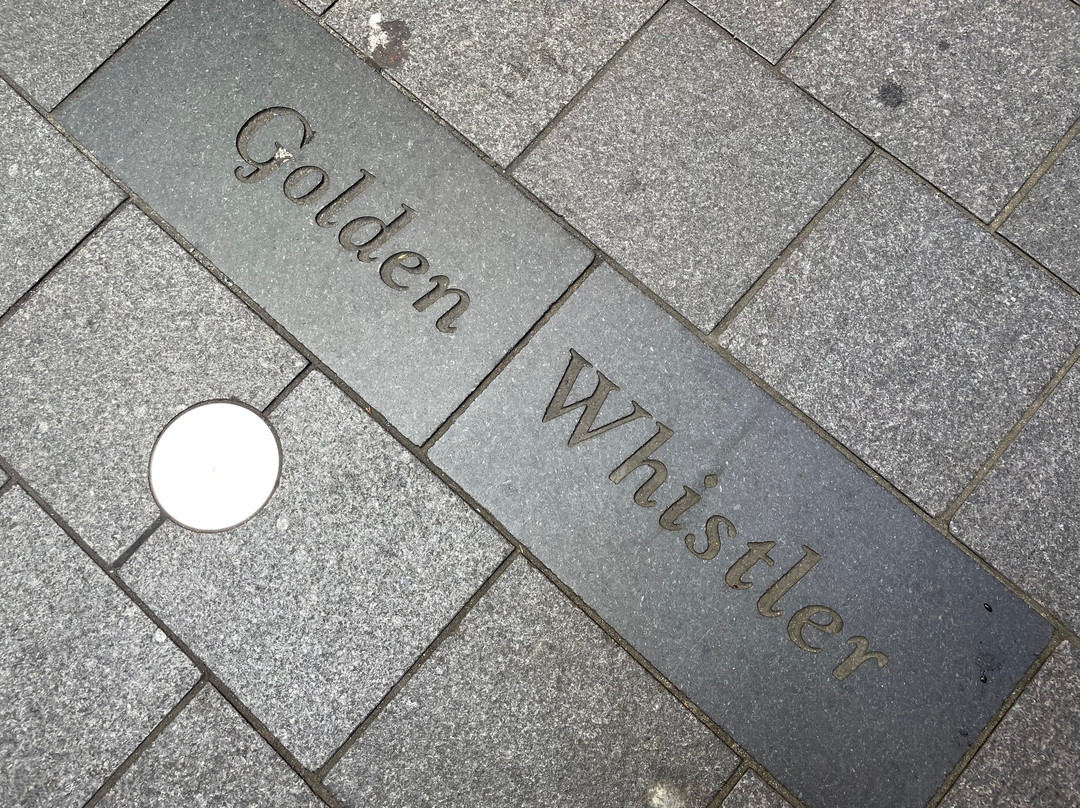的点评
Evocative Art Installation in CBD
Forgotten Songs的点评
点评:This evocatively named art installation can be found in the centre of Sydney’s CBD. It’s hidden away down one of the city’s narrow, dark laneways in Angel Place.
What you see here are a collection of more than 100 empty birdcages, strung high overhead between the walls of the alley.
The cages are pointedly empty. They represent the birds that once thrived in the area but were displaced after British settlement. Habitats were disturbed or destroyed, and over 50 species of birds were either forced out or became endangered.
As I moved around beneath the cages, the installation came alive with birdsong - warbling, whistling, twittering and tweeting.
It was not some sort of generic chirping. Each of the songs belonged to a specific species. It might be the Scarlet Honeyeater, the Golden Whistler, the Superb Lyrebird, an Emu-wren, the Leaden Flycatcher, or the Dollarbird.
During the day, you hear songs from birds which were active in daylight and at night, the songs belong to those active after dark like the Tawny Frogmouth and the White-throated Nightjar.
I almost didn’t notice, but underneath your feet the names of the different species are recorded on the pavement.
It’s a throughly captivating and thought provoking artwork.
What you see here are a collection of more than 100 empty birdcages, strung high overhead between the walls of the alley.
The cages are pointedly empty. They represent the birds that once thrived in the area but were displaced after British settlement. Habitats were disturbed or destroyed, and over 50 species of birds were either forced out or became endangered.
As I moved around beneath the cages, the installation came alive with birdsong - warbling, whistling, twittering and tweeting.
It was not some sort of generic chirping. Each of the songs belonged to a specific species. It might be the Scarlet Honeyeater, the Golden Whistler, the Superb Lyrebird, an Emu-wren, the Leaden Flycatcher, or the Dollarbird.
During the day, you hear songs from birds which were active in daylight and at night, the songs belong to those active after dark like the Tawny Frogmouth and the White-throated Nightjar.
I almost didn’t notice, but underneath your feet the names of the different species are recorded on the pavement.
It’s a throughly captivating and thought provoking artwork.
翻译:这个名字令人回味的艺术装置位于悉尼中央商务区的中心。它隐藏在天使广场 (Angel Place) 这座城市狭窄、黑暗的小巷之一中。
您在这里看到的是 100 多个空鸟笼,高高地悬挂在小巷的墙壁之间。
笼子里明显是空的。它们代表了曾经在该地区繁衍生息但在英国定居后流离失所的鸟类。栖息地受到干扰或破坏,超过 50 种鸟类被迫迁出或濒临灭绝。
当我在笼子下面走动时,装置里充满了鸟鸣声——鸣叫、口哨、叽叽喳喳。
这不是某种普通的叽叽喳喳声。每首歌都属于一个特定的物种。它可能是猩红吸蜜鸟、金口鹬、华丽琴鸟、鸸鹋鸟、铅鹟或美元鸟。
白天,您会听到白天和晚上活跃的鸟类的歌声,这些歌声属于那些在天黑后活跃的鸟类,如茶色蛙口鸟和白喉夜鹰。
我几乎没有注意到,但在你脚下的人行道上记录着不同物种的名字。
这是一件非常迷人且发人深省的艺术品。
您在这里看到的是 100 多个空鸟笼,高高地悬挂在小巷的墙壁之间。
笼子里明显是空的。它们代表了曾经在该地区繁衍生息但在英国定居后流离失所的鸟类。栖息地受到干扰或破坏,超过 50 种鸟类被迫迁出或濒临灭绝。
当我在笼子下面走动时,装置里充满了鸟鸣声——鸣叫、口哨、叽叽喳喳。
这不是某种普通的叽叽喳喳声。每首歌都属于一个特定的物种。它可能是猩红吸蜜鸟、金口鹬、华丽琴鸟、鸸鹋鸟、铅鹟或美元鸟。
白天,您会听到白天和晚上活跃的鸟类的歌声,这些歌声属于那些在天黑后活跃的鸟类,如茶色蛙口鸟和白喉夜鹰。
我几乎没有注意到,但在你脚下的人行道上记录着不同物种的名字。
这是一件非常迷人且发人深省的艺术品。



此点评仅代表旅行者个人的主观意见,并不代表TripAdvisor以及其合作方的意见。
关于我们
|
新闻动态
|
商务合作
|
会员中心
|
业主中心
|
业主通
|
常见问题
|
意见反馈
|
联系我们
|
营业执照
© 2025 Tripadvisor 版权所有。
使用条款 |隐私政策 |网站工作原理
部分照片由 VFM Leonardo 提供。
* Tripadvisor不是旅行社,也不是旅游预订服务代理商。我们提供免费、客观、公正的旅游资讯服务。 (显示更多)
TripAdvisor LLC 既不是预订代理商,也不是旅游运营商,不会向网站用户收取任何服务费。 按照规定,在 Tripadvisor 发布机票价格、游览和旅行套餐的合作伙伴(航空公司、旅行提供商及预订代理商),其标价须包含所有费用和附加费用。 例如, 机场出入境税费、消费税与其他服务费、手续费、杂费及附加费用。 当您向我们的某个合作伙伴进行预订时,请务必查阅他们的网站以了解当地行政部门要求的所有适用费用的具体情况。 除非另有说明,机票价格通常指的是一个人的价格(以人民币计)。
为方便起见,TripAdvisor LLC 根据从我们的预订合作伙伴获取的空房率计算每个酒店的均价。 对于游览和景点来说,所显示价格通常是每位成人的最低可用价格。 对于列出的任何旅行套餐或优惠,TripAdvisor LLC 无法保证任何特定的费率或价格。 此外,酒店均价每晚会更新,并以您的首选币种表示(使用现行汇率)。 由于这些已换算的价格是预估价格,因此,有关具体金额和币种请与预订网站进行核实。
此外,TripAdvisor LLC 无法保证我们网站上宣传的价格随时有效。 标价可能需要预订一定天数才能生效,或有不可用日期、使用条件或限制。
TripAdvisor公司对外部网站的内容一概不负责。优惠价格中不含税和其他费用。
ICP证:沪B2-20200433
沪ICP备20013175号
 沪公网安备31010502005427号
沪公网安备31010502005427号鹰程信息技术(上海)有限公司
货币/国家及地区
¥CNY
中国

